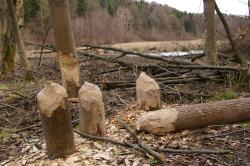 Asset Publisher
Asset Publisher
The State Forests National Forest Holding
The State Forests National Forest Holding is the largest organisation in the European Union managing forests, which belong to the State Treasury and celebrating its 90 anniversary this year.
Presently, we manage the area of one third of Poland's territory. Not long after the end of the Second World War, there was only 21 % of the area. Every year we plant 500 million of new trees, as we want Polish forests grow all the time.
Every year Polish foresters plant 500 million of trees.
85 % of nature reserves in Poland are located within the State Forests. 40 % of the forests managed by General Directorate of the State Forests are protected within the framework of European network Natura 2000. We fight against many threats: natural disasters, plaques of insects, trees' diseases, fires, pollutions, as well as poaching and vandalism.
We take care the forestry supplying the market with timber, as ecological and universal material, to be carried on in accordance with rules of balanced development (photography P.Fabjański).
One of our major tasks is making forests accessible to the society. We invite you to take advantage of these beautifully located within the forest wilderness holiday resorts, forester's lodges or guest rooms. That is for you, we create thousand kilometres of hiking trails, cycling paths or camping sites. All the above mentioned, you can find in service www.czaswlas.pl.
We also take care the forestry supplying the market with timber, as ecological and universal material, to be carried on in accordance with rules of balanced development. We obtain over 30 million of cubic meters of wood annually, twice as much as at the beginning of the nineties of the XX century.
Despite of this, the average of wood abundance per hectare of our forests is one fourth bigger than 20 years ago and 40% bigger than the average of European Union currently amounts.
In Poland in sectors connected with the forestry, there work about 375 thousand of people. It means that each 40 working Pole works in the forest.
In Poland in sectors connected with the forestry, there work about 375 thousand of people. It means that each 40 working Pole works in the forest. The sector of wood processing works out approximately 8 % of our GDP (Gross Domestic Product). Among others, thanks to the timber from the State Forests Poland is the 10 largest producer of furniture in the world, and the 4 largest furniture exporter.
The State Forests employ 25 thousand people. That way we are the 9 biggest employer in Poland. Among the largest companies in our country it takes 22 place in respect of its incomes and 11 place in respect of its profits. The value of assets, we manage, reaches 300 million zl. If we add social values, it will be worth one billion zlotych. We do not use money from the budget, but we earn money on our own to support the business. In spite of the financial crisis, since 2002, we continuously note down profits. Moreover, we pay taxes amounting 1,3 billion zl annually.
87 % of Poles think, the foresters are competent. We willingly share our knowledge of Polish forests, of their history and of nature values with the others. We publish books, periodicals, brochures; we also administer the website www.lasy.gov.pl . For children, the youth and teachers, we prepared internet service "E-lynx' Lynx Forest" (www.erys.pl). Our staff has supported schools in field of nature education for years. We also organise many actions to let people broaden their knowledge about forest, nature and ecology.
 Asset Publisher
Asset Publisher
 Asset Publisher
Asset Publisher
Rezerwat Mójka
Rezerwat Mójka
Rezerwat został utworzony dnia 25 lipca 1997 roku na powierzchni 288,80 ha w leśnictwie Kąkolówka (oddz. 81-89) w celu zachowania ze względów naukowych, dydaktycznych i krajobrazowych kompleksów lasu bukowo-jodłowego oraz osiedlonego w zbiorowiskach wodno-błotnych bobra.
Rezerwat leży w granicach Hyżnieńsko-Gwoźnickiego OChK. Do najcenniejszych elementów przyrody rezerwatu, stanowiących główny przedmiot ochrony, należą ekosystemy leśne tworzone przez lasy jodłowe ze znacznym udziałem buka.
Na uwagę zasługuje obecność wilgotnego podzespołu żyznej buczyny karpackiej z czosnkiem niedźwiedzim, kwaśnej buczyny górskiej a także nadrzecznej olszyny górskiej.
Cenną fitocenozą jest również grąd subkontynentalny. Bogactwo florystyczne wyraża się obecnością 340 gatunków roślin naczyniowych, w tym 24 chronionych ( 18 objętych ochroną ścisłą). Na uwagę zasługuje wśród nich: listera jajowata, storczyk szerokolistny i plamisty, podkolan biały, cebulica dwulistna, podrzeń żebrowiec, widłaki: goździsty, jałowcowaty i wroniec, kłokoczka południowa i zimowit jesienny. Za szczególną osobliwość florystyczną rezerwatu należy uznać rosnący tu w znacznym skupieniu czosnek niedźwiedzi.
W drzewostanach rezerwatu występują okazałe, wiekowe egzemplarze drzew spełniających kryteria pomników przyrody, z których na szczególną uwagę zasługuje buk o oddz. 86b, osiągający obwód 310 cm. Interesująca jest fauna omawianego obiektu na czele z bobrem europejskim, z pozostałych gatunków należy wymienić: dzięcioła trójpalczastego, salamandrę plamistą. Na terenie rezerwatu pojawia się również bocian czarny. W rezerwacie można odnaleźć kilka interesujących elementów przyrody nieożywionej, np. w południowo-wschodniej jego części znajduje się interesujący kamień będący pomnikiem przyrody.
Na granicy oddziałów 84h oraz 87a, w dolinie potoku, znajduje się rumowisko skalne z naniesionych przez potok różnej wielkości głazów i kamieni. Na potoku występują niewielkie, ale dość liczne wodospady.
Przez teren rezerwatu prowadzi ścieżka przyrodniczo - edukacyjna. Utworzona wspólnym wysiłkiem Gminy Błażowa i Nadleśnictwa Strzyżów.


 fot. Paweł Fabijański
fot. Paweł Fabijański
 fot. Paweł Fabijański
fot. Paweł Fabijański
 fot. Paweł Fabijański
fot. Paweł Fabijański











